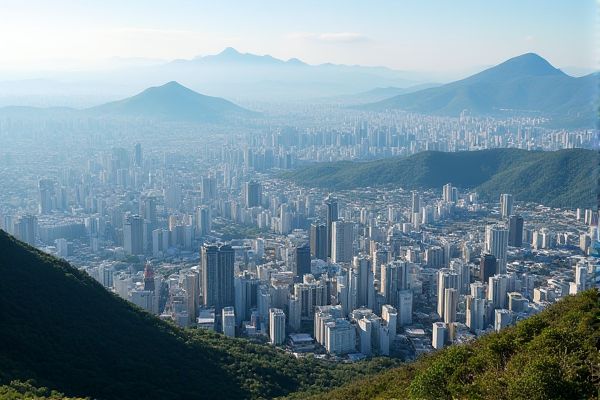
Transportation and commuting in South Korea: Extensive subway network. Affordable public transportation. T-money transportation card. Regular bus services. High-speed KTX trains. Taxi availability and affordability. Bicycle-friendly cities. Congestion during rush hour. Intercity bus routes. English signage in major areas.
Extensive subway network
The Seoul subway network is one of the most efficient and extensive in the world, operating from approximately 5:30 AM to midnight, with 23 lines, 768 stations, and clear color-coded signs in Korean, English, and Chinese. The system allows free transfers between subway lines and offers multiple journey passes like Tmoney, with additional features such as free WiFi and platform screen doors in all stations. For more detailed information about this remarkable system, visit the Visit Seoul website.
Affordable public transportation
South Korea offers highly affordable and efficient public transportation, featuring cheap trains, buses, and taxis. Travelers can simplify their journeys by using rechargeable transportation cards such as Namane, Tmoney, and Cashbee, which help to reduce costs and allow free transfers between buses and the subway. For more detailed insights on the best ways to navigate the country, visit their Lonely Planet article for guidance.
T-money transportation card
The T-Money Card is a prepaid transportation card used for public transportation in South Korea, including buses and subways, offering lower fares compared to cash payments and additional uses in convenience stores, restaurants, and attractions. It can be purchased at Incheon Airport, convenience stores, and subway stations, and topped up at various locations. For more detailed information on its benefits and usage, visit the T-Money Card guide available online.
Regular bus services
Regular bus services in South Korea are categorized by color: Blue Buses (trunk buses) cover long distances within cities, Green Buses (branch and village buses) connect local areas to main transport hubs, Yellow Buses (circulation buses) operate in loop routes during peak hours, and Red Buses (express buses) connect cities to surrounding suburbs, each with distinct routes and fare structures. For more detailed information on these categories and their unique operations, visit the comprehensive guide on Korea Bus.
High-speed KTX trains
The High-Speed KTX Trains in South Korea, operated by Korail, connect major cities like Seoul and Busan with speeds of up to 305 km/h and a maximum of 330 km/h. These trains offer two classes, comfortable seating, onboard amenities including WiFi and vending machines, and have significantly reduced travel times across the country. To learn more about the impressive capabilities and offerings of the KTX, visit the KTX Trains website for a comprehensive overview.
Taxi availability and affordability
Taxis in South Korea, particularly in Seoul, are relatively affordable, with base fares starting at 4,800 won for the first 1.6 kilometers, although fares have recently increased. Despite the affordability, taxi availability can be challenging, especially at night, due to a shortage of drivers and the preference for higher-value fares facilitated by taxi booking apps like KakaoT.
Bicycle-friendly cities
South Korea has several bicycle-friendly cities, with Sejong City standing out for its extensive bike paths and large sidewalks, making it the best city to cycle in. Other notable cities include Seoul, Gwangju, Daejeon, and Daegu, which offer useful bike paths along rivers and around the city, although Seoul's paths can be more congested.
Congestion during rush hour
Seoul experiences severe traffic congestion during rush hours, as commuters spend an average of 1.5 hours driving to and from work. The congestion in the city is described as having a tree-like structure in the morning, with an exponential increase in congested flows between 6 to 9 A.M., and more persistent loop structures in the evening. This pattern is driven by the diffusion and stacking of local congestion. In addition to road traffic, Seoul's subways also face extreme congestion, with some lines operating at over 250% of their passenger capacity, which raises significant safety concerns. Unfortunately, the city's transportation policies are often criticized for their inefficacy in addressing these ongoing challenges. For more insights into the issue, The Korea Herald provides detailed examinations of these traffic phenomena and their implications for daily commuters in Seoul.
Intercity bus routes
South Korea's intercity bus system offers an affordable and convenient way to travel, with extensive routes connecting major cities like Seoul to Busan, Sokcho, and Jeonju. Tickets can be purchased online or at bus terminals, and the buses provide various seat options, including economy, excellent, and premium, with frequent departures and comfortable travel times. For more detailed information on planning your journey, visit the Klook Blog to explore all your options.
English signage in major areas
In major areas of Seoul, such as Gangnam District, Seongsu-dong, and Yeonnam-dong, there is a trend of using English signage over Korean (hangul), which can alienate older Koreans and those who are not proficient in English. This phenomenon persists despite the law requiring hangul on certain signs. The situation has sparked discussions on how Korea treats its people, as the growing prevalence of English signage often caters more to younger generations and foreigners, potentially leaving behind those not as fluent. For further insights, visit Korea JoongAng Daily as they delve deeper into this issue, providing a comprehensive look at its societal implications.
